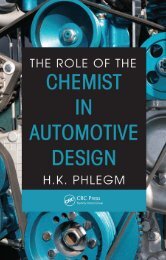Lightweight Electric/Hybrid Vehicle Design
Lightweight Electric/Hybrid Vehicle Design
Lightweight Electric/Hybrid Vehicle Design
You also want an ePaper? Increase the reach of your titles
YUMPU automatically turns print PDFs into web optimized ePapers that Google loves.
Process engineering and control of fuel cells, prospects for EV packages 85<br />
fuel and material restrictions limit the practical efficiency to about 50%, which is achieved by<br />
modern, large, low speed diesel engines, but automotive gasoline and diesel engines achieve much<br />
lower efficiencies, particularly when averaged over a standard driving cycle.<br />
A true direct energy conversion device is one which can convert the Gibbs free energy of a<br />
chemical reaction directly into work. A fuel cell converts the Gibbs free energy of a chemical<br />
reaction into a stream of electrons under isothermal conditions. The change in Gibbs free energy<br />
of a reaction is given by:<br />
ΔG r = H r − TS r<br />
Fuel-cell reactions which have negative entropy change (e.g. H 2 + (1/2)O 2 = H 2 O) generate heat<br />
and those with positive entropy change (e.g. C 2 H 6 + 3.5 O 2 = 2CO 2 + 3H 2 O and CH 3 OH + 1.5O 2 =<br />
CO 2 + 2H 2 O) extract heat from the surroundings. For a fuel cell operating at constant temperature<br />
and pressure, the maximum electrical energy is given by the change in Gibbs free energy:<br />
W el = −ΔG = nFE (1)<br />
Where n = the number of electrons in the reaction, F = Faraday’s constant (96 500° C/equivalent)<br />
and E = the reversible potential. If all reactants are at standard conditions of 1 atm and 25 o C:<br />
For the reaction<br />
ΔG o = −nFE o (2)<br />
H 2 (g) + (1/2)O 2 (g) = H 2 O(l)<br />
the Gibbs free energy change 12 is −237 kJ, n = 2, and therefore the maximum reversible potential,<br />
E o = 1.23 V. The maximum reversible potential under actual fuel-cell operating conditions can be<br />
calculated from the Nernst equation. For the general reaction:<br />
aA + bB = cC + dD<br />
The free energy change can be expressed:<br />
ΔG = ΔG o + RT ln([C] c [D] d /[A] a [B] b )<br />
Substituting equations (1) and (2) gives:<br />
E = E o + (RT/nF) ln([A] a [B] b /[C] c [D] d<br />
For the hydrogen/oxygen fuel cell this can be simplified 1 to:<br />
E = Eo 1/2 + (RT/2F) ln[PH2/PH O] + (RT/2F) ln[PO ]<br />
2 2<br />
Normal practice for conventional power generation is to use the thermal efficiency, expressed<br />
as the electrical output as a percentage of the heat of combustion of the fuel. It is common practice<br />
in Europe to use the lower heating value (LHV) or lower calorific value (LCV) (water as gas),<br />
whereas in the United States it is common practice to use the higher heating value (HHV) or Gross<br />
Calorific Value (GCV) (water as liquid). The heat of combustion is equal to −ΔH, the change in<br />
enthalpy. The thermal efficiency of a fuel cell is given by:<br />
Gibbs free energy converted to electricity<br />
Thermal efficiency = Enthalpy change ( −heat of combustion)







